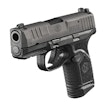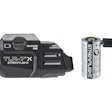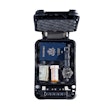More than 3,000 innocent people died on Sept. 11, 2001, and one major contributing factor was lack of training and, in particular, lack of weapons awareness training on the part of security personnel. You see, it makes absolutely no difference whatsoever how much sophisticated state-of-the-art detection equipment is at your disposal. If you don't know what the weapons you're searching for look like, you won't find them.
As police officers on the streets of our cities, you face potentially deadly disguised and hidden weapons every single day. A key, a cigarette package, a lipstick, a watch, a comb, even a gum wrapper are among the literally hundreds of common, everyday items that have been used, converted, or adapted into concealed and deadly weapons.
That innocuous-looking watch could just mean your time is up; that ordinary pen could be used to write your death warrant. If you don't assume that every personal item on a suspect hides a potentially lethal device, you could end up dead from what you thought was a piece of Juicy Fruit gum. A lack of basic training in weapons awareness and recognition could kill you and the people in your care.
Weapons Awareness
It is the very ordinary appearance of some of these weapons that makes them so lethal. Disguised, improvised, adapted, converted, commercially manufactured, or homemade; they pose a deadly threat to all law officers. The design and concealment of a weapon is only limited by an individual's imagination. My book, "The Manual of Prohibited and Concealable Weapons," includes almost a thousand images of different types of weapons, their use, and methods of their concealment. Some are unmistakable-they look exactly like weapons, but a significant number look like anything but weapons.
The overriding principle of most weapons awareness and detection training is, if it looks like a gun, it is a gun; if it looks like a knife, it's probably a knife, and if it looks like a bomb there's a good chance it's a bomb. Easy enough. But what if the gun doesn't look like a gun? Or the knife doesn't look like a knife? If you only look for the obvious things, those are the only things you'll ever find.
It is imperative that all law enforcement officers receive training that teaches them to look more closely at the innocuous-looking items-pens, mobile phones, rings, matchboxes, combs and brushes, belts, credit cards, just to name a few. In fact, all the things that definitely don't look like weapons are just the things that should be scrutinized. In other words, don't trust anything; they could all be weapons of one kind or another. Always assume that they are. Objects are guilty until proven innocent when searching a suspect. Believe me, there are little old grandmothers out there capable of killing you with what's in their purses.
Disguised Firearms
Let's look at firearms first. While every three-year-old kid knows what a gun looks like, very few law enforcement officers or security professionals know what guns can be made to look like.
Gun manufacturers, particularly those in Eastern Europe, seem to be devising more and more firearms that are particularly difficult to recognize and, therefore, detect. Guns built to look like mobile phones, key-ring fobs, signet rings, pens, screwdrivers, penknives, cigarette lighters, belt buckles, and even cigarette packets are all out there. Many have been specifically designed to defeat security. They have all been designed to deceive and kill.
Besides the commercially manufactured hidden guns, you also have to watch out for the homemade and improvised ones. They are all just as lethal as their professionally made cousins. Some are extremely crude in design and manufacture, and the users often run the risk of blowing their own fingers off. However, many are very well made and are becoming increasingly more sophisticated.
Some improvised firearms are conversions and some have even been adapted from kid's toys. Today's treacherous criminals are more inventive than ever before and will go to great lengths to acquire or fashion their own homemade firearms. Unfortunately, in my experience the vast majority of professional security personnel and police officers are blissfully unaware that these disguised guns even exist, or just how small a firearm can actually be. I am engaged in the preparation of an international disguised and adapted firearms initiative with the UK National Criminal Intelligence Service and Interpol, to try and address some of these awareness issues.
Disguised Knives
Edged weapons are, without question, among the easiest of all weapons to conceal. Contrary to popular belief, a knife does not have to be over 3 inches long to be lethal. It doesn't even have to have a point and it definitely needn't be made of steel. I have studied examples of disguised knives with blades no more than a half-inch long, which will kill just as efficiently as any 8-inch stiletto.
Homemade and improvised edged weapons can be among the most dangerous. Why? Because they don't look like weapons. For example, a thug can Superglue a razor blade onto the back of a credit card with just a fraction of an inch protruding over the edge. It will nestle in his wallet quite innocently with the rest of his credit cards and yet is capable of slitting someone's throat from ear to ear. He can still probably walk onto any aircraft in the world with this type of weapon, unchallenged, but security will relieve him of his nail clippers.
There are also many examples of commercially manufactured, disguised blades. Staying with the credit card theme for a moment, in December last year some members of the media smuggled several edged weapons on board an aircraft traveling from a major UK airport. One of the items was a little beauty called the Spydercard, a very slim, credit-card-sized, folding knife. It is highly concealable, incredibly sharp, and can be opened very quickly with one hand. Knives like these have been around for years, and not just the Spydercard. Other examples include the vicious razor-like Tekan Security Card and the Tool Logic Credit Card Companion, which conceals a formidable spear-point, serrated push-dagger.
Knives like these are sitting in wallets and purses all over the world. How many police officers and security personnel are still unable to recognize and detect these items and could pay the ultimate price, through an abject lack of knowledge and training? With the proliferation of modern, stylish clothing accessories and personal carry-bags such as backpacks and bum-bags ("fanny-packs" in the States), vicious criminals have even more places in which to conceal lethal weapons.
Many examples of awesome-looking knives are manufactured and sold for the purpose of personal protection. Although the vast majority are made of traditional materials, there are many that are manufactured in high-impact plastic or a glass-reinforced nylon called Zytel. Some are even molded to look like hairbrushes and yet they are all capable of inflicting just as much damage as any steel blade. With names such as The Cat, Ace of Spades, Delta Dart, and the CIA letter opener, plastic and Zytel weapons pose a major threat to you.
Cigarette lighters are so common in all our lives, we almost don't notice them. Unfortunately, Europe is overrun with ordinary-looking, fully functional cigarette lighters that hold a nasty little secret: automatic switchblades. Yes, you can light someone's cigarette and stab them in the eye at the same time. Nice.
Point is, if you can hide a flick-knife in a lighter, you can hide a blade in anything, including pens, lipsticks, belt buckles, key fobs, coins, and jewelry. Is that a crucifix or a dagger? It might be both! Only recently, a major UK police force identified a vicious and highly concealable edged weapon adapted from a wire coat hanger.
The key to preventing tragedy from hidden and disguised weapon attacks is to know they exist. If you know about them, you have more chance of detecting them and therefore surviving an encounter with a suspect carrying them. Your best defense is training, training, and more training.
Defending Against Disguised Weapons
What can a law enforcement officer do to guard against the growing threat of unusual concealed weapons?
The first thing is to be aware they're out there and understand how they may be used against you. "We teach a block in our basic academy about unusual concealed weapons," says Lt. Dave Spaulding, a 26-year veteran with the Montgomery County (Ohio) Sheriff's Department. "When new items show up on the street, we put together a training bulletin, which is a one- to two-page notice about the weapon, with a close-up picture and detailed description. That notice goes out to every officer at our roll call."
The second thing an officer can do to guard against a disguised weapon attack is to use all appropriate procedures and tactics when approaching and controlling a suspect.
"A double arms length from suspects lets you see their hands but gives you a gap to react in if they move," Spaulding says. "You need to watch the suspect's hands and be aware of any indicators of violence. Anything in the suspect's hands could be used as a weapon. Many times officers are so keyed into looking for a gun or a knife, they won't look carefully at a cell phone, or look in a wallet to see if there's a credit card knife in there."
Some departments have actually changed their search methods to address concerns about hidden weapons. "We've recently modified our search procedures in light of studies that showed that the old way we did it, with the suspect's hands on the car and legs spread, left us vulnerable," says Patrolman Tim Hanks, a 10-year veteran and FTO with the Minneapolis, Police Department. "Now we have the suspect interlock his fingers behind his head. We approach from the rear, and with one hand take all 10 fingers and pull the suspect backwards into an off-balance position while we conduct the search."
Spaulding heartily approves of this technique. "You want to make sure that the suspect is in a position of disadvantage at all times," he says. "Never face them when you're doing a search. Be aggressive, don't be timid or hesitant in your search because a criminal will pick up on it and use it against you, especially when searching the groin area. They'll heckle you, ask if you're gay, do anything to distract you. You want to stay alert, because that's what will keep you alive." Spaulding also advocates that patrol officers invest in a good set of puncture-resistant gloves to guard against needles.
Corrections officers face a specific threat from unusual concealed weapons. "The most dangerous time for a corrections officer is when the cuffs come off a suspect in the reception area," says Spaulding. "The suspect's first perceived opportunity will be when the cuffs come off. Then one of these weapons, like a belt buckle knife or something else, might come into play."
- Marcus Wynne
Steve Collins is CEO of PS5 Ltd., a consultancy dealing with the design and production of training and educational materials for law enforcement. His book, "The Manual of Prohibited and Concealable Weapons," is acclaimed as the definitive weapons awareness guide. It is available from Varro Press at www.varropress.com for $345, plus shipping and handling.












